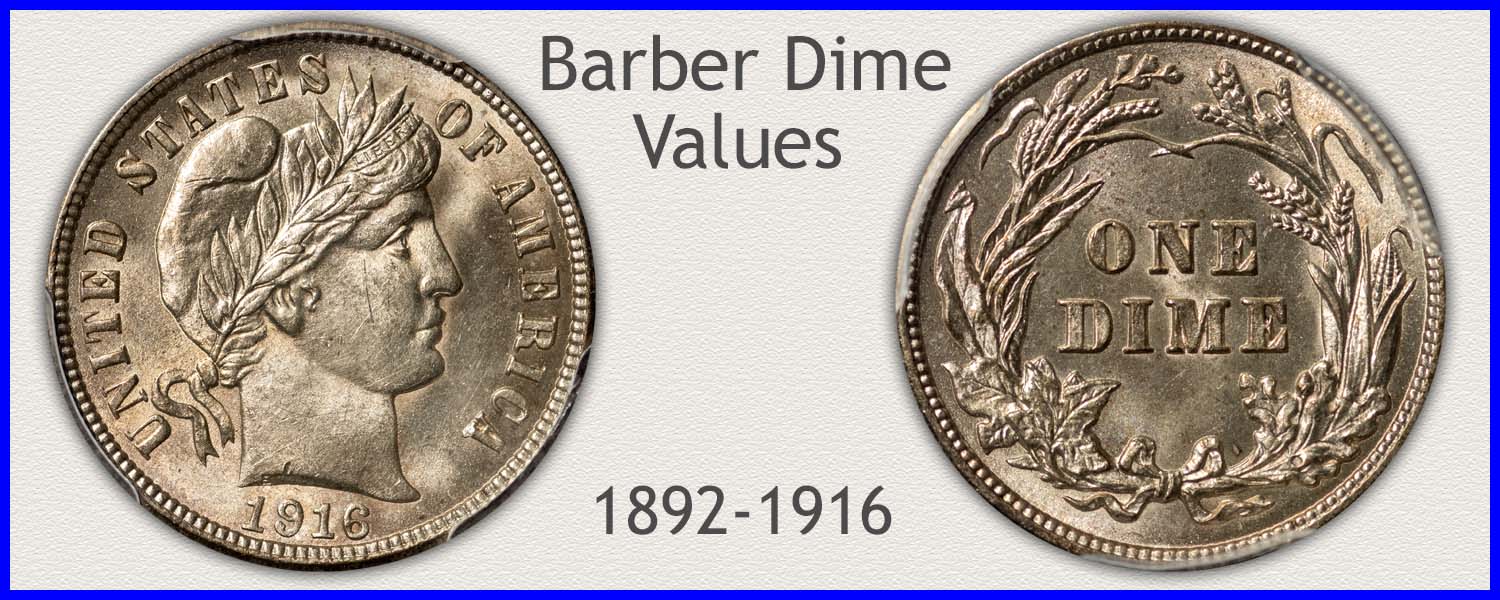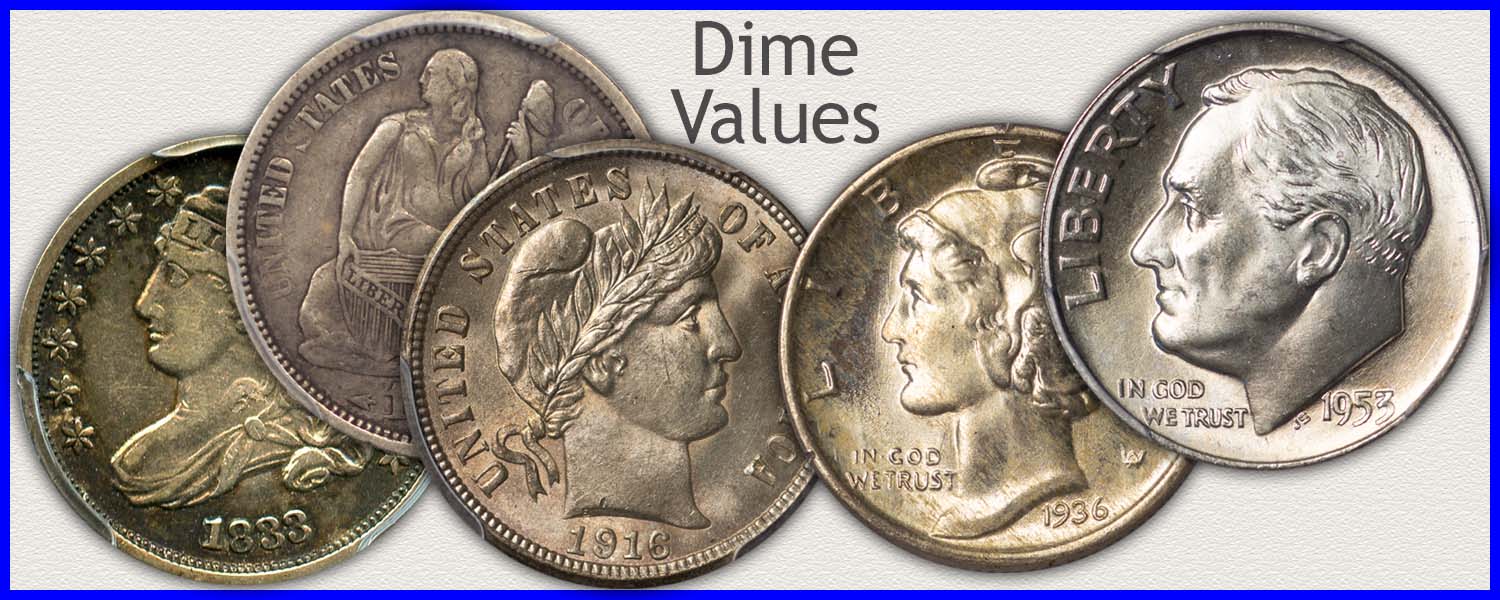Coin Values Moving with Precious Metals: Up-Dated 12/15/2025: Gold $4341 | Silver $63.26
1892 Dime Value
Use the series of images helping recognize the different mintmark varieties and narrow 1892 dime value.
Defining the exact date and mint variety of Barber dimes is how these dimes are collected. Collector demand for the less available issues is showing as higher premiums. Listings on the chart also indicate the better-preserved coins are in strong demand.
Images used in a defined process, identify mintmarks and their locations, followed with a series of grading images helping determine condition.
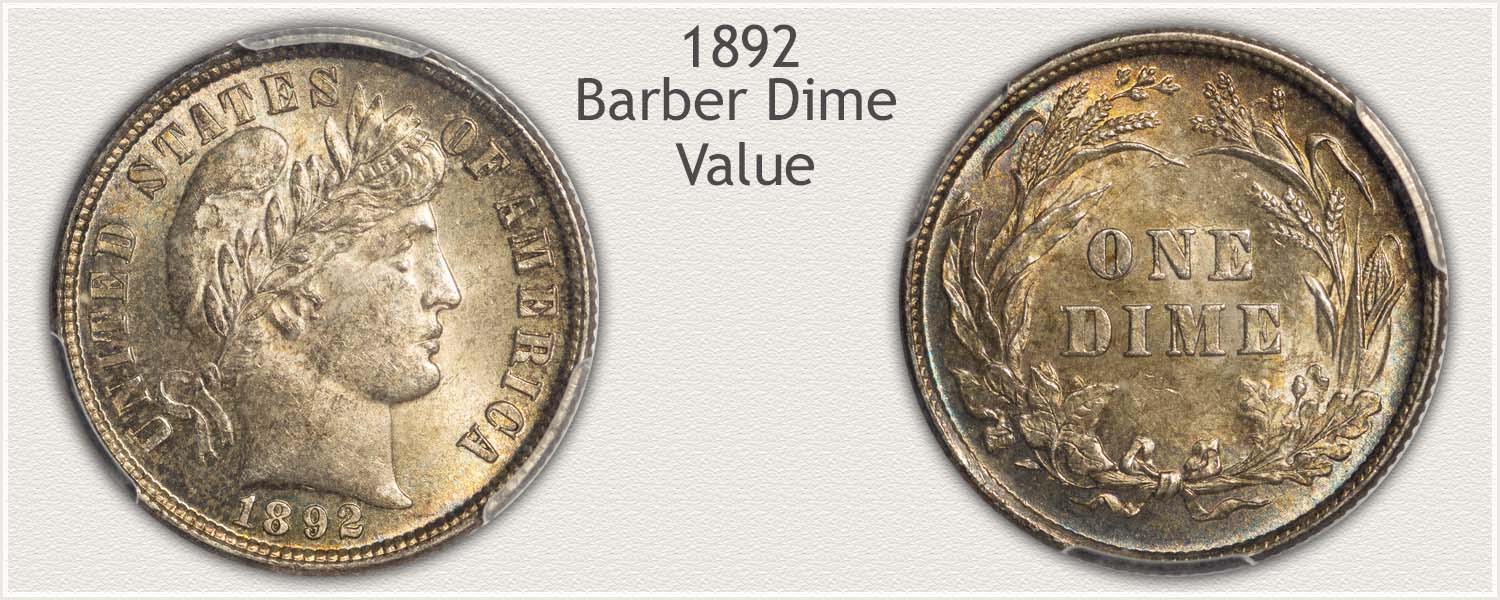
Steps Leading to Value:
- Step 1: Date and Mintmark Variety - Sought-after date and mintmark combinations by collectors are identified. High premiums note the scarcity of these mint varieties of 1892 dimes.
- Step 2: Grading Condition - There are visible differences in the condition of these Barber dimes. With the use of images, grading defines the condition of an old dime to find out where it belongs on the value chart.
- Step 3: Special Qualities - Historical "First Year of Series" and a variety of ways to collect 1892 dimes, assures their popularity and value.
| 1892 Dime Value | ||||
|---|---|---|---|---|
| Condition of Coin | ||||
| Date | Good | Fine | Extremely Fine | Mint State |
| Barber Dime Values Updated | 12/15/2025 | |||
| 1892 | $19.03 | $13 | $39 | $100 |
| 1892 O | $12.13 | $27 | $61 | $211 |
| 1892 S | $72 | $146 | $189 | $357 |
Values listed on chart are Wholesale. Use these values as a starting range. Dealer's needs, precise condition of the coin all narrow this range.
Step 1: | Confirm Date and Mintmark Issue
Identify the Popular San Francisco 1892 Dime
1892 dimes, first year of the new design series, were produced in large quantities at the main mint in Philadelphia and lesser quantities at two branch mints.
To identify the coinage of branch mints, small letters were placed on the fields of the coins representing each branch mint. 1892 dimes are recognized by collectors as having three issues to include in a set.
Mintmarks and locations are imaged to identify the different mint's coins and their place on the value chart. Note that San Francisco dimes are in special demand because of scarcity.
1892-S Barber Dime
"S" Mintmark on Reverse: San Francisco Mint Struck the Coin
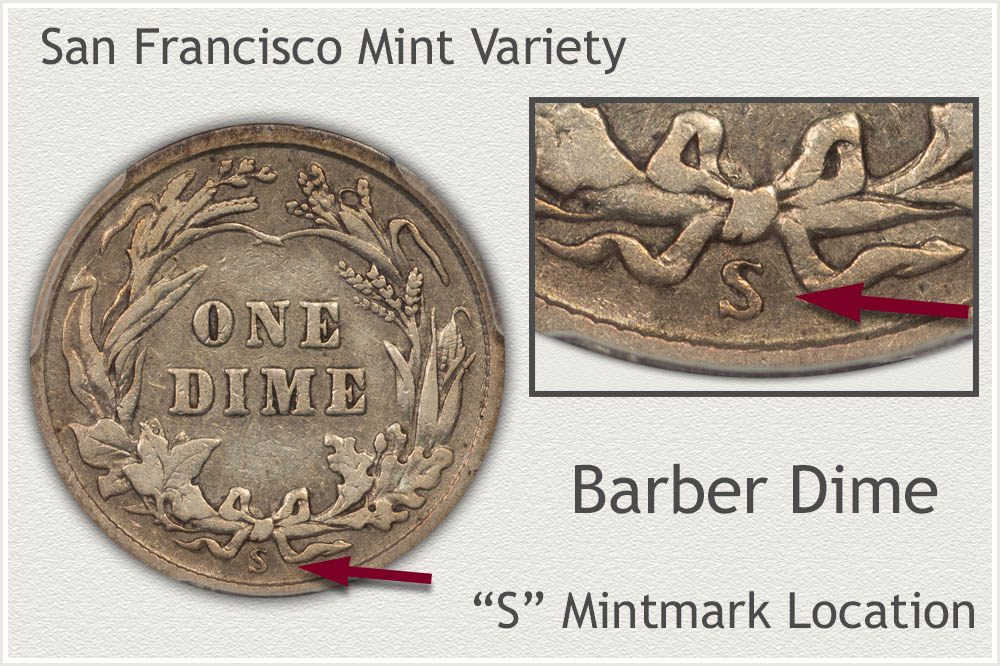
An accurate description of a coin includes the date and mint variety. 1892 dimes are significant as the first year of the series, and the western mint in San Francisco issued just under one million into circulation. Because of its low numbers produced, these are a highly valued coin.
Confirm the San Francisco issue by the "S" mintmark on the reverse. Below the wreath, the "S" mintmark is clearly seen next to the rim. An in-demand collectible.
1892-O Barber Dime
"O" Mintmark on Reverse: New Orleans Mint Struck the Coin
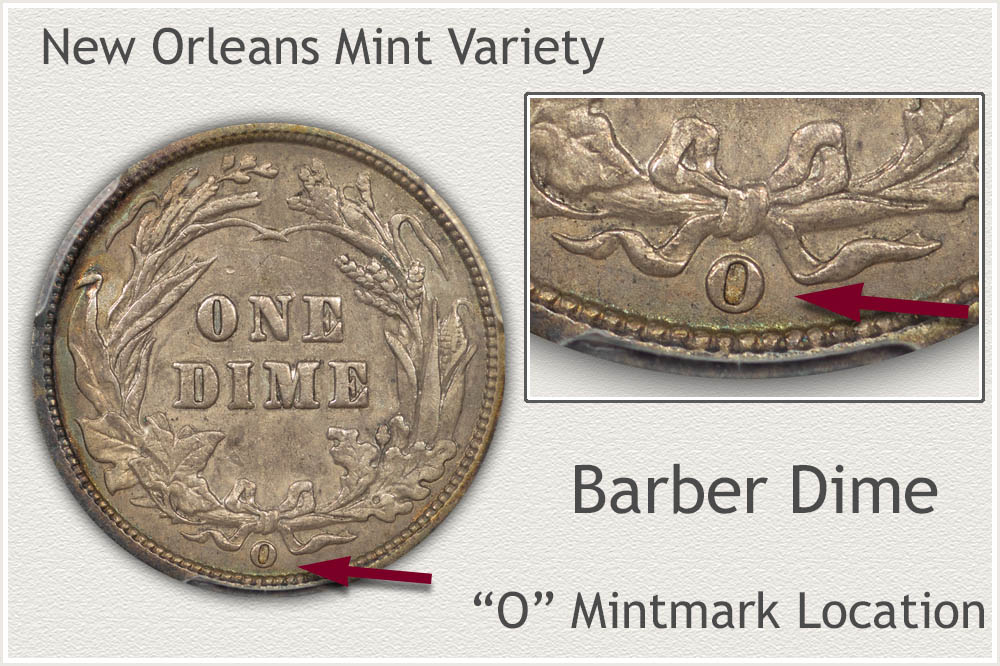
The New Orleans mint was one of three mints contributing to the initial release of the new 1892 Barber dime series. Striking an abundant number; 3.8 million dimes, these are affordable and very popular with collectors. With the status of "first year of series" and the interest of collectors in the New Orleans mint, all show a premium on the value chart.
New Orleans was a branch mint serving the South, and all of its coinage features an "O" mintmark. Identify the mint by finding the "O" on the reverse along the lower rim, just below the bow tying the wreath.
1892 Barber Dime
No Mintmark on Reverse: Philadelphia Mint Struck the Coin
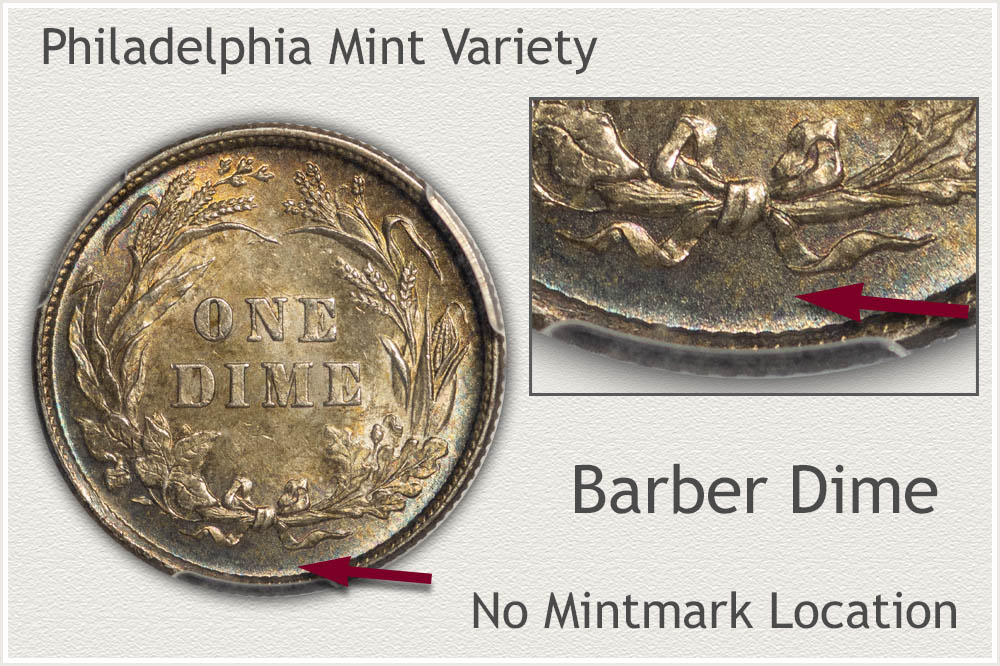
The beginning of the Barber series saw the Philadelphia mint strike an abundant amount of 1892 dimes. Listed on the chart, values of coins in heavily worn condition are tied to silver content. These are a popular issue with collectors because of affordability and "first year" of issue. Placing an accurate value requires correct identification.
Confirming the Philadelphia variety is the absence of a mintmark on the reverse. Philadelphia is the main U.S. mint and, at the time, did not use mintmarks to identify its coinage. Inspecting the reverse, look just below the wreath, along the rim. If the area is empty, Philadelphia struck the coin.
Step 2: | Grading Identifies 1892 Dime Value
Judge Condition to Find Collectible Quality
Barber dimes are valued by collectors according to their condition. Amount of wear to the surface is examined and judged and a grade is established. Standards of different levels of wear are imaged to compare and help define a narrow grade range.
Bold features of the design typically wear in recognizable patterns as metal is removed. Highlighted in the following images are specific areas to focus.
Mint State Grade
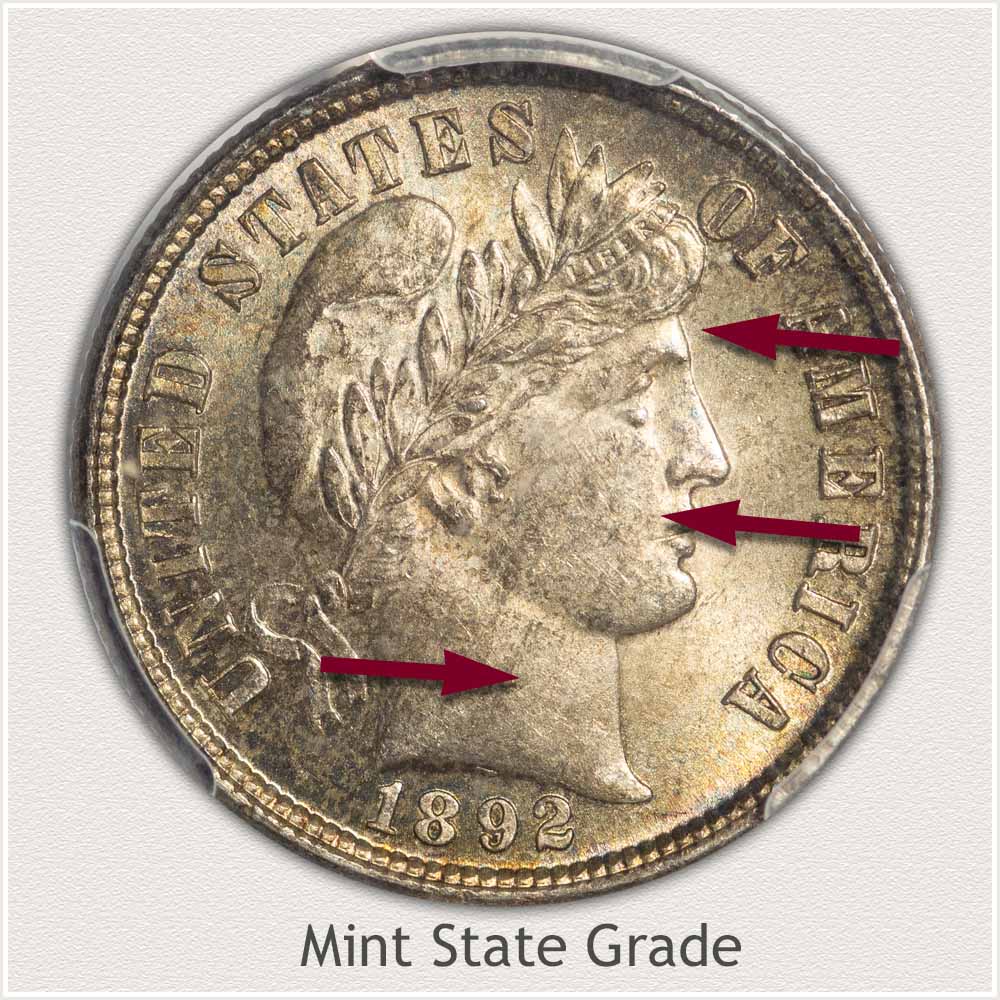
Mint State: A coin in Mint State condition is a standout example of these vintage Barber dimes. All of the design elements are still visible, and there is no surface wear on them. A complete covering of luster adds to their quality, creating the shine seen on mint state grade dimes.
The striking process produces a delicate, fine grain to the metal as it moves over the die and into the recesses, resulting in luster. During use in circulation, this fine texture wears away quickly. Verify that Liberty's cheek is completely covered in luster. Comparing her neck, another exposed region, to the face and cheek; both have a lustrous sheen. Silver becomes dull when worn, losing its sheen and develops a light grey color to the highest, worn areas.
The lustrous shine also covers the high relief elements of mint state dimes. Examine Liberty's brow closely, as it is a prominent feature. There is no dulling or smoothness of the metal in the raised edge of the brow.
While tilting a mint state coin under a light, complete bands of luster are visible on its surface. These coins are high collector quality.
Extremely Fine Grade
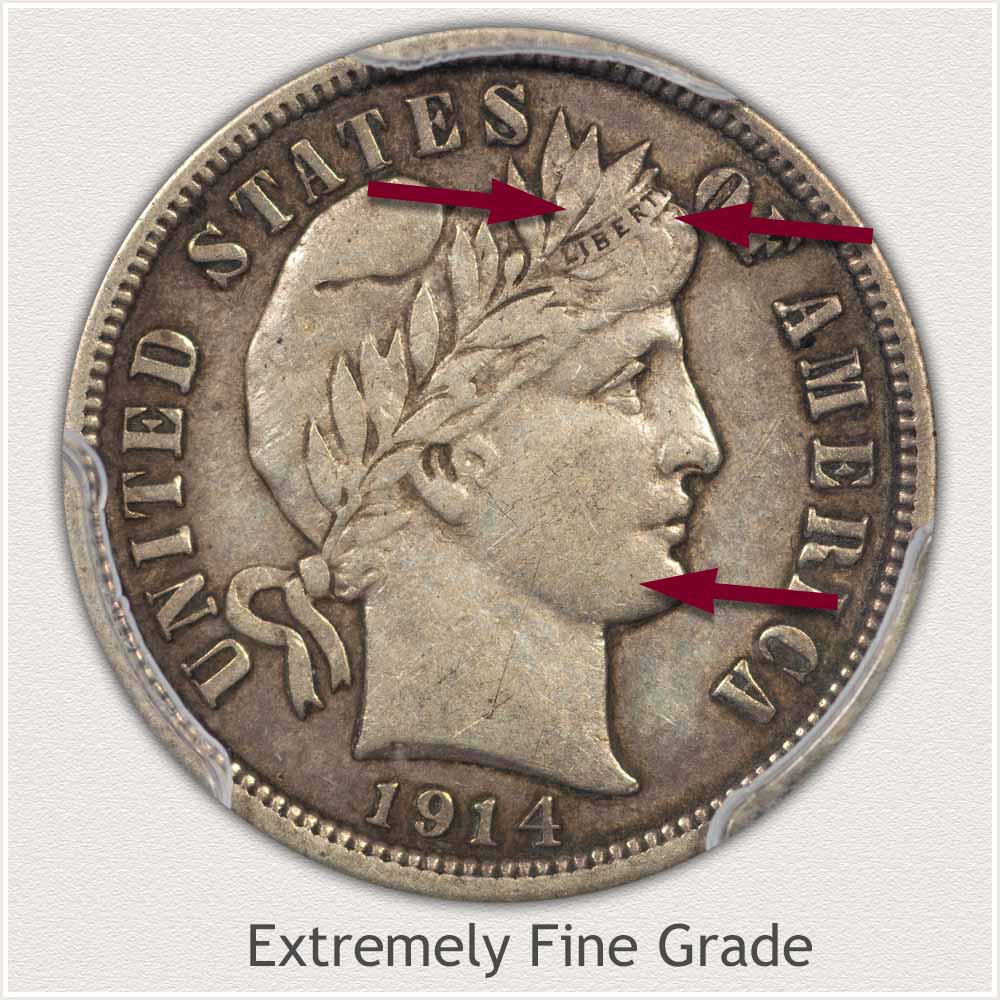
Extremely Fine: Light wear appearing only on the highest points defines a Barber dime in Extremely Fine condition. Important are small details remaining visible helping qualify for the grade.
Appealing to collectors are lightly circulated dimes with just a touch of wear. These become an excellent start to assembling collections of the series. One feature required of a high-quality dime is fine details are clearly visible, worn, but distinct. Within Liberty's hair is a ribbon with letters of "Liberty". It is important both the top and bottom edges of this ribbon remain visible to reach the Extremely Fine grade. Strong, defining edges to the ribbon indicate only light wear is present.
A soft grey color tone is now the overall appearance of the silver. Light wear has removed most of the luster. Indicating only light wear, the fine curl of hair in front of the ear is clearly seen. This small detail wears quickly and when visible, helps this coin qualify for the high collectible grade.
When viewing the coin overall, a crisp, detailed "look" to the design remains. Small areas of wear are visible on high points, and the fields of the coin are just lightly worn and slightly smooth in texture.
Fine Grade
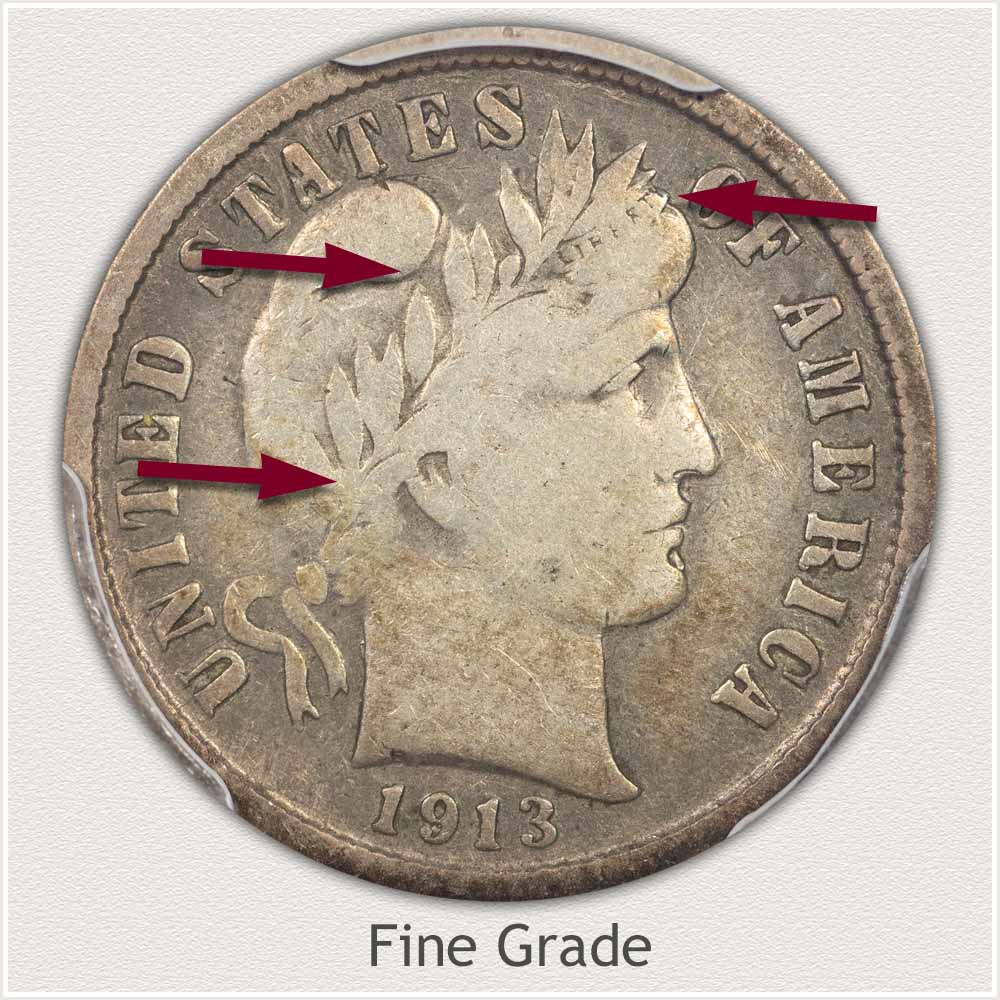
Fine Grade: Moderate wear that still displays many minor and major details helps define a Barber dime in the Fine grade. These coins seem worn at first glance; however, the majority of the portrait design is still visible.
A quality coin in Fine condition displays detail in the leaves of the Laurel wreath, and some of Liberty's hair is still visible. Identify, all the leaves that point upward are completely outlined and very defined. Although the lower leaves are merging with the hair, there are a few subtle features showing the lower part of the wreath.
Next confirm, all letters of "Liberty" are visible in the ribbon within the headband, which is an important feature of the Fine grade. This detail is frequently lacking complete letters of "ER", with some letters being faint or incomplete. A strong Fine grade dime has bold, crisp lettering of the legend along the edge.
Judge Liberty's ear, which has developed noticeable flatness as a result of use. There is enough detail left to distinguish the ear from the cheek. This is a somewhat worn example, notability, with a defined ear merging only at the top with the hair, is a collectable fine grade example.
Good Grade
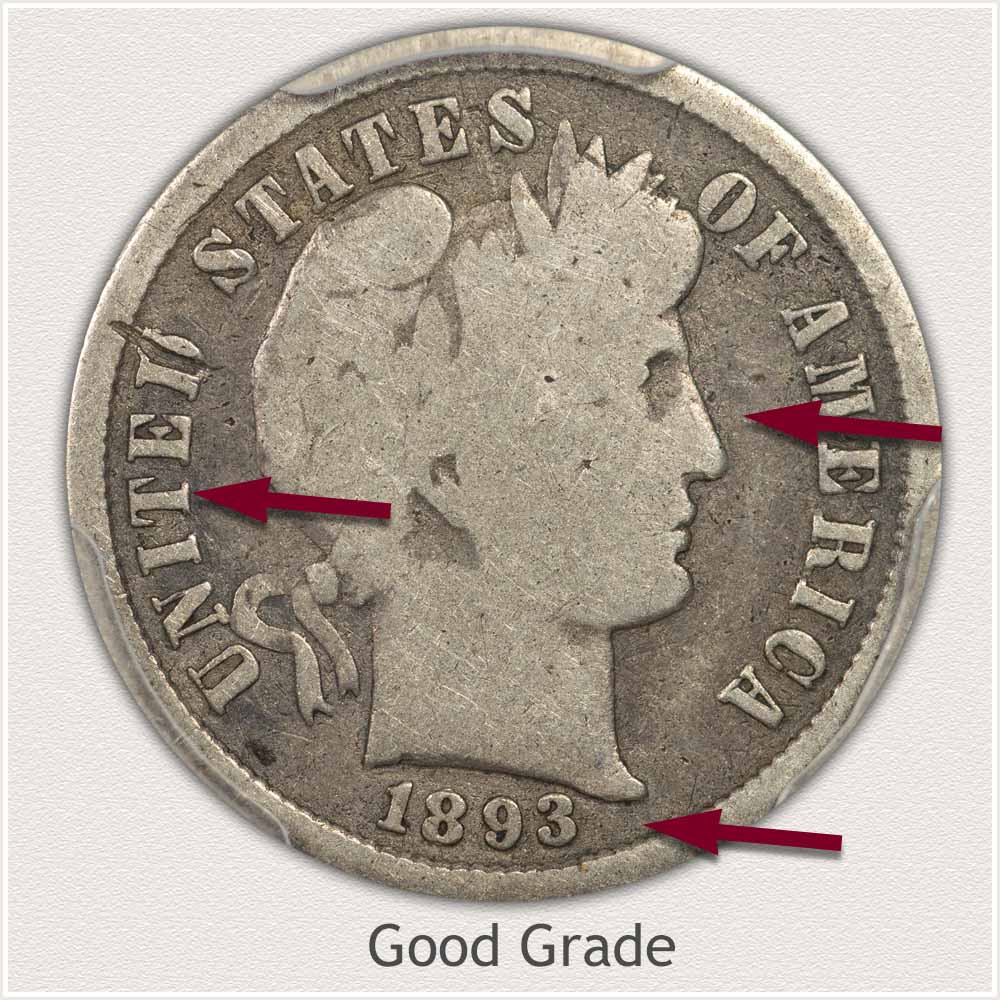
Good Grade: Heavily circulated Barber dimes with few design elements remaining are considered in Good condition. These are visibly lacking any central details, only outlines of the design remain.
One of the best features of the Barber design is the highly raised portrait of Liberty. All of the finer details are worn smooth in good condition, with a full outline of the portrait remaining. With the portrait well raised from the field, this becomes an added plus to the grade.
Eye appeal is improved by the presence of a strong date, and all letters along the rim are full. No merging with the rim is confirming the grade. A good-grade Barber dime is worn, however, without wide spread fading of portrait and letters into the field. Overall impression is worn but not "worn out".
How to Video: Grading Barber Dimes
Improve the ability to judge conditions and recognize greater quality. Fine details are studied in depth.
Video, Images and Descriptions | Grading Barber Dimes
Step 3: | Special Qualities of Historical Design Change
1892 Dime Historical Importance and Value Demand
Among the many factors influencing the value of 1892 dimes is the historical "first of series" status the coin enjoys. Everyone takes notice as an older design, the Seated Liberty series, is replaced by a new one.
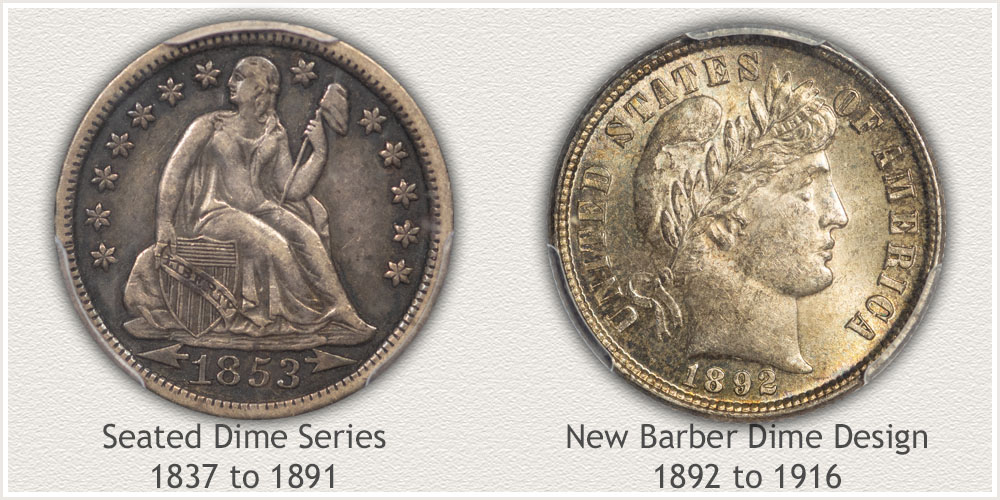
The older design of a Seated Liberty was in use since 1837 a total of 54 years. A familiar and comfortable coin with the public.
Replacing a Seated Liberty, the Barber design is a side portrait of Liberty wearing a Liberty cap. Additional details include laurel leaves over the cap, a ribbon inscribed with LIBERTY, and waves of hair just below the ribbon. The name Barber dime is in reference to designer Charles E. Barber, who was instrumental in finalizing the design of the coins.
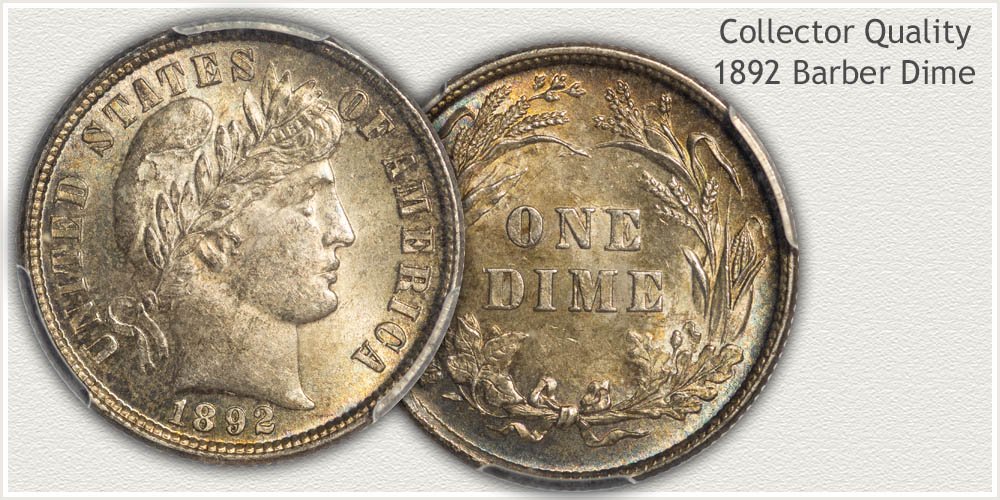
Remaining familiar with the public is the reverse design of the new Barber dime. Featuring a wreath of oak, corn, and wheat surrounding TEN CENTS. It is very similar to the preceding design series.
Demand for these Barber dimes today is based on the variety of ways they are collected. One theme is a set containing an example of each year the series was produced. Extending the set and adding each mint variety to the year set is popular. Type sets of dimes, representing one each of the many designs over the years, is an important set of coins.
In addition to the different themes are the levels of new to advanced collectors seeking these coins. Nicely detailed, circulated examples, are sought by the new and beginning collector as affordable. Advanced collections feature high grade pieces. 1892 is a year that fits well in all of these sets with its significance as the first year of a design change.
The value chart is indicating the importance of condition. Notable is the quick rise in value as less wear is present on the coin. San Francisco 1892 dimes in particular are very scarce in nice condition.
- Historical Importance: First of Status Plus Major Design Change
- Scarce in Nice Condition: Challenging and rewarding when found
- Demand From Many Collectors: 1892 is an essential year for a variety of collecting themes
A new design series, Barber dimes of 1892, are all worth a close inspection to recognize the special qualities of the year. Date, mint variety, and state of preservation.
References
U.S. Mint. 1891 U.S. Mint Annual Report
https://nnp.wustl.edu/library/book/512060
U.S. Mint. 1893 U.S. Mint Annual Report
https://nnp.wustl.edu/library/book/317
Coin Values | CoinStudy Articles
Date by Date
In Depth Barber Dime Values
1892 to 1916
Barber Dime Value | Dates and Mints Listed
Discover the different dates and valuable mintmarks. Use the step by step method to an accurate identity and value of these old Barber dimes. Grade condition and note mintmarks to complete your assessment.
Dime Values | Identify the Different Series
As part of the value process, use the images to identify the dime series. Each is linked to in depth coverage of dates and mints to recognize. The different series are covered with specific grading images to judge condition, one of the important steps to an accurate value.
Coin Value Guide | How to Value a Coin Collection
Identify all series of U.S. coins. Proceed through specific steps to recognize the different date and mint combinations narrowing value range. Images are then used to grade condition and find the value on charts.
Rare Dimes | Date and Mint Combinations
A dime is considered rare for many reasons. Demand for low mintage dates within popular series, examples from the Carson City mint are another example. The many different series of dimes with scarce date and mint combinations are featured.
Coin Grading Services | Professional Review of Condition
Date, mint, and condition are the three key elements to coin values. Seek a professional judgment of grade to realize the true potential of your higher value coins.
★Coin Values Discovery finds 1892 Dime Value and...
A review of the value process with image links to series and current coin value. Determining how much a collection of coins is worth follows a few steps helped by images and detailed descriptions.
